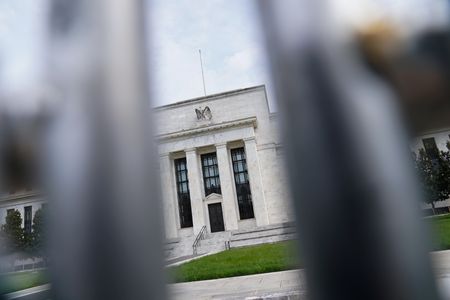By Michael S. Derby
NEW YORK (Reuters) -Changes last week to a Federal Reserve lifeline for banks should not impair the facility’s ability to provide liquidity to banks that still genuinely need the cash, and also have appeared to deter a steady rise in borrowing over recent months, market analysts believe.
That is because the facility, known as the Bank Term Funding Program, or BTFP, still offers fairly easy terms conditions to access it even as it now costs more to borrow from the central bank, the analysts said. That is important, since over recent days some regional Fed banks have run into challenges that have in turn stoked worries about the sector, thus raising questions whether the central bank was premature in tightening access to the BTFP.
Just over a week ago, the Fed raised the borrowing rate on the BTFP, an effort launched in March to provide easy cash to eligible banks amid the high-profile implosion of Silicon Valley Bank, which in turn had raised fears of broader banking sector stress.
The BFTP borrowing rate now matches the interest on reserves rate at 5.4%, representing around an immediate half-percentage-point rise in borrowing costs for those aiming to take on new BTFP loans. The Fed also affirmed the program would shut down as planned on March 11.
Raising the rate was widely viewed as a way to arrest a vexing rise in borrowing at the facility despite no apparent signs of bank stress. The change appears to have had some impact, with banks borrowing $165.2 billion from the facility as of Jan. 31, from $167.8 billion on Jan. 24.
By raising the rate, the Fed in theory closed off what had been an ability by banks to borrow cheap cash from the Fed and lend at higher rates in private markets or even to the Fed itself. The BTFP borrowing rate is now higher than the rate seen on many private money market securities and matches what the Fed pays banks to park reserves at the central bank.
Borrowing at the BTFP has “probably peaked” given the new terms and the retreat in usage was “what you would have expected,” said Steven Kelly, associate director of research at the Yale School of Management’s Program on Financial Stability.
Raising the rate “was the right move,” said Joseph Wang, chief investment officer at Monetary Macro. Moving the BTFP rate to the interest on reserve rate “weeds out the opportunistic borrowing and leaves those that actually need the cash.”
Derek Tang, an analyst with forecasting firm LH Meyer, also believes the facility remains in a good place to provide support, noting banks have been using it “not because of the lower BTFP rate…but because BTFP was so much looser with collateral valuation and margin, and that hasn’t changed.”
Despite jittery markets, Fed officials do not themselves appear concerned about the health of the banks. That confidence appeared to embolden policy makers to take out of the Federal Open Market Committee policy statement released Wednesday language describing the banks as “sound and resilient,” words first employed in the March 2023 statement and carried forward until the latest FOMC gathering.
(Reporting by Michael S. Derby; editing by Diane Craft)
